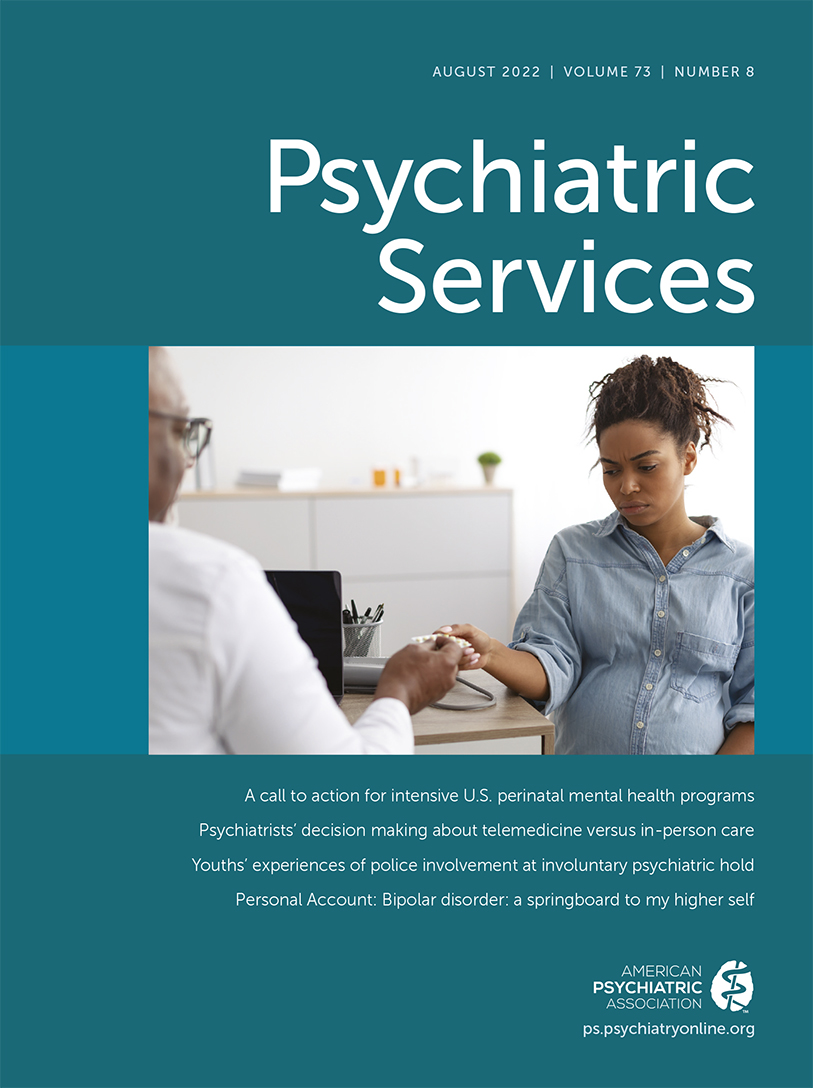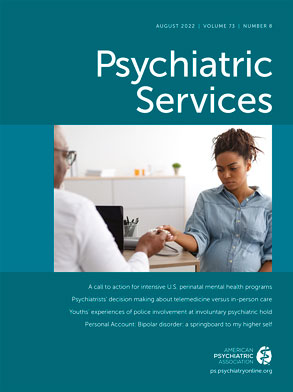Appropriateness of Telemedicine Versus In-Person Care: A Qualitative Exploration of Psychiatrists’ Decision Making
Abstract
Objective:
Methods:
Results:
Conclusions:
HIGHLIGHTS
Methods
Study Participants and Sampling Strategy
Interviews
Critical Incident Technique
Clinical Vignettes
Data Analysis
Results
| Characteristic | N | % |
|---|---|---|
| U.S. regiona | ||
| Northeast | 5 | 25 |
| West | 7 | 35 |
| South | 3 | 15 |
| Midwest | 5 | 25 |
| Practice setting | ||
| Community health centerb | 3 | 15 |
| Community mental health center | 1 | 5 |
| Hospital-based outpatient clinic | 7 | 35 |
| Non–hospital-based behavioral health specialty group practice | 3 | 15 |
| Partial hospitalization or intensive outpatient program | 1 | 5 |
| Solo private practice | 5 | 25 |
| Patient population | ||
| Adults only | 7 | 35 |
| Children and adults | 13 | 65 |
| Practice location | ||
| Large city | 9 | 45 |
| Suburb | 4 | 20 |
| Rural area or small town | 7 | 35 |
| Time in outpatient setting | ||
| Full-time (≥35 hours per week) | 14 | 70 |
| Part-time (10–34 hours per week) | 6 | 30 |
| % of visits via telehealth in the previous month (mean and range) | 59 | 13–90 |
Decision-Making Context
Impact of spring 2020.
Decision making without constraints.
Role of patient preference.
General Beliefs About and Approach to Hybrid Care
Candidates for telemedicine.
Beliefs about hybrid care.
Telemedicine as part of longitudinal care.
Visit frequency.
If you get more communication and contact with the patient [via telemedicine], that supersedes the loss that you get from not seeing her in person if she’s missing appointments because of work. . . . I think it’s realistic to work with her on televisits to ensure those more frequent contacts.
My general philosophy with patients is that any contact is better than no contact. I’m pretty sure that with this patient if I were to insist, “Oh no, I don’t do telemedicine, you have to come in,” then he would just be noncompliant with care.
When you have these patients who are at risk for falling out of care, if you don’t offer them telemedicine, but [they] are also at risk for getting slightly suboptimal care when you do offer them telemedicine, it is a very case-by-case judgment call in terms of the risks and benefits of enabling the telemedicine.
Facilitating engagement.
I want to treat this [hypothetical patient with agoraphobia], and I might have a goal to wean him off telemedicine once he’s doing better, to not feed into his agoraphobia too much. But I wouldn’t have a problem with starting with telemedicine.
Telemedicine as a bargaining chip.
I want you to walk. You’re telling me you’re out of shape. So, we’re going to have a tradeoff. All the time that you would spend, all the energy and all the dread coming to see me in my office because you don’t even want to leave the house, I need you to take walks around the block for me. Is that a fair deal? Otherwise, I’m still going to make you come and see me [in person], and it’s a hassle.
I set boundaries [for telemedicine visits with patients with lower function], like you have to be fully clothed, you have to be sitting up. . . . I told a patient, please be fully focused on the interview. You shouldn’t be cooking. I phrased it as a warning, and if [the distraction] continues, then the visits will need to be in person, or they can be discharged from the clinic.
Factors Influencing the Decision to Offer Telemedicine to Individual Patients
Required elements for therapeutic rapport.
Contextual considerations.
Challenging conditions or situations.
Discussion and Conclusions
BOX 1. Clinical vignettes
Supplementary Material
- View/Download
- 124.42 KB
References
Information & Authors
Information
Published In
History
Keywords
Authors
Competing Interests
Funding Information
Metrics & Citations
Metrics
Citations
Export Citations
If you have the appropriate software installed, you can download article citation data to the citation manager of your choice. Simply select your manager software from the list below and click Download.
For more information or tips please see 'Downloading to a citation manager' in the Help menu.
View Options
View options
PDF/EPUB
View PDF/EPUBLogin options
Already a subscriber? Access your subscription through your login credentials or your institution for full access to this article.
Personal login Institutional Login Open Athens loginNot a subscriber?
PsychiatryOnline subscription options offer access to the DSM-5-TR® library, books, journals, CME, and patient resources. This all-in-one virtual library provides psychiatrists and mental health professionals with key resources for diagnosis, treatment, research, and professional development.
Need more help? PsychiatryOnline Customer Service may be reached by emailing [email protected] or by calling 800-368-5777 (in the U.S.) or 703-907-7322 (outside the U.S.).

